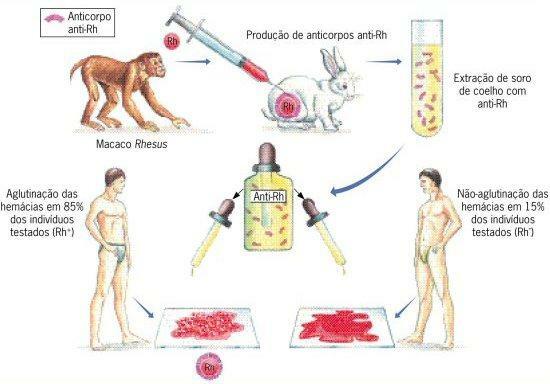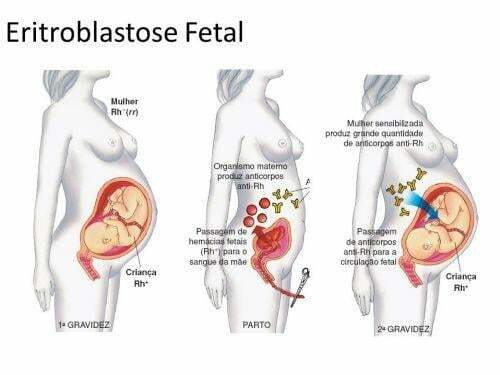The Rh system was discovered in 1940 by scientists Landsteiner and Wiener, using red blood cells from monkeys of the Macaca rhesus species, hence the name Rh system. Landsteiner and Wiener injected the red blood cells from these monkeys into rabbits and observed that antibodies were formed to try to fight them. The blood of the guinea pigs, in this case the rabbits, was centrifuged and a serum containing the antibodies that agglutinated the blood of the monkeys could be obtained. These experiments led to the discovery of an antigen on the membrane of red blood cells that was different from the A and B agglutinogens, which they called anti-Rh.

see more
Biology teacher fired after class on XX and XY chromosomes;…
Cannabidiol found in common plant in Brazil brings new perspective…
This antigen is controlled by independent genes, that is, the genes of the Rh system have no connection with the genes of the ABO system. We can find the same red blood cell proteins in many different animals, such as humans and the higher apes, who may share several types of existing blood systems. This infers an evolutionary clue for these species.
In the experiment performed by Landsteiner and Wiener, drops of blood from a human subject that contained the serum anti-Rh, more than 80% of the individuals had agglutination and only the rest had no agglutination. It was then concluded that the group in which the blood sample agglutinated presented the Rh antigen and were called the Rh+ group and the one that did not agglutinate did not have the antigen, thus being called the group Rh-.
Negative individuals are not going to show antibodies if they receive, at some point in their lives, red blood cells with Rh positive. The inheritance of the Rh factor is conditioned by three genes: RR, Rr or rr, with R being the dominant allele that expresses the Rh+ factor and r the recessive allele that expresses the Rh- factor.
| Genotypes | Phenotypes |
| RR | Rh+ |
| Rrr | Rh+ |
| rrr | Rh- |
The difference in the Rh factor in a couple can cause hemolytic disease of the newborn, also known as erythroblastosis fetalis. This happens when an Rh- woman has children with an Rh+ man because, in that case, there are two possibilities of Rh factor for the children, which will be conditioned if the man is pure (RR) or hybrid (Rr). If the man is pure, all the children of this couple will be Rh+, if he is a hybrid, both Rh+ and Rh- children can be born.
When the first child has Rh-, that is, the same as the mother, there is no incompatibility because the two do not have antigens. However, if the first child is Rh+, the mother may come into contact with the child's red blood cells during delivery and even days before the birth. birth when a small amount of blood from the fetus escapes into the maternal organism and, being sensitized and starting to produce the anti-Rh antibody.
The production of this antibody is not immediate and the first child will not have incompatibility with the mother, but if this couple has another child with Rh+, during pregnancy the mother's antibodies will already be concentrated in the blood and can cross the placenta, thus causing the agglutination of the fetal erythrocytes, then the child will be a carrier of hemolytic disease of the newborn or erythroblastosis fetalis, which can cause the death of the baby.
In many severe cases, a miscarriage occurs when erythroblastosis fetalis affects the fetus. If the child is born, it can be saved if there is a gradual exchange of its blood for another one that has Rh-, in this way the erythrocytes will not be destroyed and the child's body will have time to eliminate the mother's antibodies until he produces Rh+ red blood cells again.
Fetal erythroblastosis can be prevented if soon after the first birth of an Rh+ child, the Rh- mother receives an application of anti-Rh antibodies. They will destroy the red blood cells positive that the fetus left in the mother's blood and prevents the sensitization of her organism, that is, the triggering of the production of maternal antibodies that will cause problems in the second son. As the mother's body has not "learned" to manufacture antibodies, the mother is free to have another child without the possibility of the disease.

There are dozens of blood systems used in the human species as we can find many different antigens on the surface of red blood cells. In the MN system the two genes found are known as LM and LN. The LM gene produces M antigen and the LN gene produces N antigen. These genes are codominant and therefore this group has three genotypes and three phenotypes as well, see the table below.

In this system, the production of antibodies also only happens after sensitization. The study of these different blood groups is important to determine characteristics of origin and evolution, to carry out blood transfusions and also to determine paternity in populations human.
Denisele Neuza Aline Flores Borges
Biologist and Master in Botany